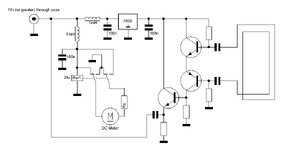neazoi
Advanced Member level 6
I would like to control the direction of a small (toy) DC motor by applying different voltage levels to it.
The motor is to be used on an outdoors rotor.
The rotor will control the direction of a small magnetic loop antenna.
There will be an RF preamplifier for the loop near the loop.
The whole system will be powered and controlled through the coaxial cable only.
The idea is to have say 12v present at the coaxial all the time. At this time, the motor will be off. When for example 15v is present at the coaxial, the motor will turn clockwise. When for example 24v is present at the coaxial, the motor will turn anti-clockwise.
Obviously the RF preamplifier will have an onboard regulator which will stabilize these higher voltages to 12v needed by the preamplifier.
So there will be 3 states
1. 12v, the RF preamplifier is on.
2. 15v (example) the RF preamplifier is on and the motor rotates clockwise.
3. 24v (example) the RF preamplifier is on and the motor rotates anti-clockwise.
I would love to do that using discrete circuits.
Maybe a simple DPDT 24v relay?
The motor is to be used on an outdoors rotor.
The rotor will control the direction of a small magnetic loop antenna.
There will be an RF preamplifier for the loop near the loop.
The whole system will be powered and controlled through the coaxial cable only.
The idea is to have say 12v present at the coaxial all the time. At this time, the motor will be off. When for example 15v is present at the coaxial, the motor will turn clockwise. When for example 24v is present at the coaxial, the motor will turn anti-clockwise.
Obviously the RF preamplifier will have an onboard regulator which will stabilize these higher voltages to 12v needed by the preamplifier.
So there will be 3 states
1. 12v, the RF preamplifier is on.
2. 15v (example) the RF preamplifier is on and the motor rotates clockwise.
3. 24v (example) the RF preamplifier is on and the motor rotates anti-clockwise.
I would love to do that using discrete circuits.
Maybe a simple DPDT 24v relay?
